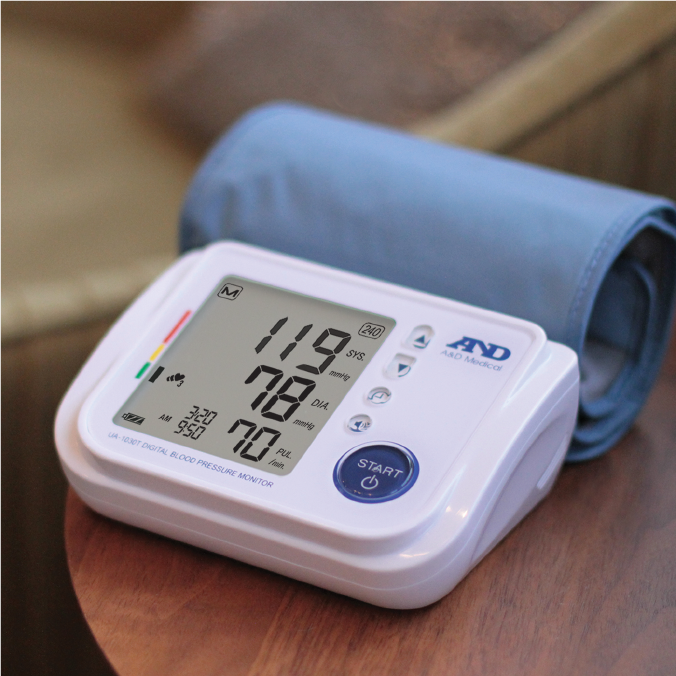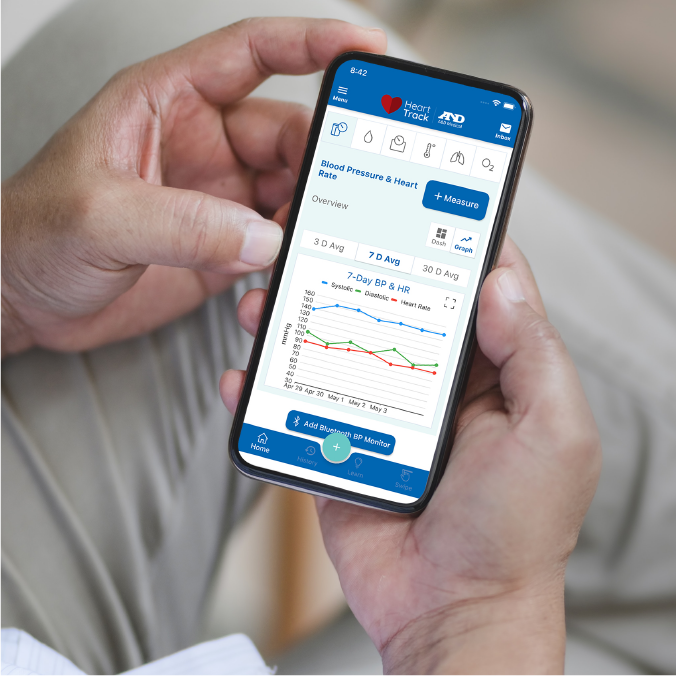Our most common questions regarding A&D Medical products are about our Blood Pressure Monitors and Blood Pressure in general. If you have a question that is not answered here, please feel free to contact us for more support.
BLOOD PRESSURE MONITORS
General Blood Pressure Information
What is Blood Pressure?
Blood pressure is the force exerted by blood against the walls of the arteries. Systolic pressure occurs when the heart contracts; diastolic pressure occurs when the heart expands. Blood pressure is measured in millimeters of mercury (mmHg).
What is Hypertension?
Hypertension (also known as high blood pressure) is the diagnosis given when blood pressure readings consistently rise above normal. It is a serious condition that well known that hypertension can lead to coronary heart disease, stroke, heart attack, kidney failure, and other health problems or other illness if left untreated. Referred to as a “silent killer” because it does not always produce symptoms that alert you to the problem, hypertension is treatable when diagnosed early.
Can Hypertension by controlled?
In many individuals, hypertension can be controlled by altering lifestyle and minimizing stress, and by appropriate medication prescribed and monitored by your doctor. The American Heart Association recommends the following lifestyle suggestions to prevent or control hypertension:
- Don’t smoke.
- Reduce salt and fat intake.
- Maintain proper weight.
- Exercise routinely.
- Have regular physical checkups
- Monitor your blood pressure at periodic intervals.
What Affects Blood Pressure?
Blood pressure is affected by many factors: age, weight, time of day, activity level, climate, altitude and season. Certain activities can significantly alter one’s blood pressure. Walking can raise systolic pressure by 12 mmHg and diastolic pressure by 5.5 mmHg. Sleeping can decrease systolic blood pressure by as much as 10 mmHg. Taking your blood pressure repeatedly without waiting an interval of 5 minutes between readings, or without raising your arm to allow blood to flow back to the heart, can also affect it.
In addition to these factors, beverages containing caffeine or alcohol, certain medications, emotional stress and even tight-fitting clothes can make a difference in the readings. Read more information from the AHA here.
Why measure blood pressure at home?
For many individuals, blood pressure readings taken in a doctor’s office or hospital setting might may be elevated as a result of apprehension and anxiety. This response is commonly called “white coat hypertension.”
The AHA and the AMA both recommend self-measurement at home to supplement in office readings to rule out “white coat hypertension” and provide a more accurate, complete blood pressure history.
Clinical studies have shown that the detection and treatment of hypertension is improved when patients both consult their physicians and monitor their own blood pressure at home.
What is a baseline measurement?
The most important method to get an accurate blood pressure measurement is consistency. To get the most benefit out of your monitor, it is important to establish a “baseline measurement.” This helps build a foundation of measurements that you can use to compare against future readings. To build this baseline measurement, devote two weeks for consistent blood pressure monitoring. This involves doing everything the same way when you measure (e.g. measuring during the same time of day, in the same location, sitting in the same chair, using the same cuff, etc.). Once you establish your baseline measurement, you can start evaluating if your measurement has been affected based on things lifestyle changes or medication treatment.
How do I record my blood pressure?
Blood pressure readings are typically recorded with the systolic pressure written first, followed by a slash mark and the diastolic pressure. For example, 120 mmHg systolic and 80 mmHg diastolic measurements are written as 120/80. Pulse is simply written with the letter “P” followed by the pulse rate—P 72, for example. You can also download the A&D Heart Track app (free on iOS and Android) to digitally log your readings.
Blood Pressure Measurement Accuracy
Are your blood pressure monitors FDA approved?
All of A&D’s blood pressure monitors have FDA clearance. This is a requirement to sell in the US market. Learn more about Clinical Validation here.
My reading seems high. Is something wrong with the monitor?
Many factors can impact your blood pressure readings, including that your cuff might be too small. A cuff that is too small yields a measurement that is higher than the correct blood pressure. Be sure to check that you are using the correct cuff size before taking your blood pressure. Please reference the section called “Select the correct cuff” in the instruction manual or see “How do I know which cuff size will fit me?” to determine your correct cuff size. If your measurements still seem high, please consult your physician.
Why do my blood pressure readings vary so much during the day?
An individual’s blood pressure varies greatly (as much as 30 to 50mmHg) from day to day and season to season due to various conditions during the day. For hypersensitive individuals, these variations are even more pronounced. Normally, blood pressure rises during work or play and falls to its lowest levels during sleep.
Please consult your physician immediately if you have any doubt about your readings.
Why are my readings different between home and at a doctor’s office?
Your blood pressure readings taken in a doctor’s office or hospital setting may be elevated as a result of apprehension and anxiety. This response is known as “white coat hypertension”.
When I bring my home monitor to a doctor’s office, why do I get a different measurement than what’s taken by a doctor or nurse?
The healthcare professional may be using a different sized cuff. The size of the bladder inside the cuff is critical for the accuracy of the measurement. This may give you a different reading. A cuff too large will produce a reading that is lower than the correct blood pressure; a cuff that is too small will produce a reading that is higher than the correct blood pressure. There may also be other factors that can cause the difference in measurements.
Cuff Sizing
I am told I need to use a large cuff, but I fit into a standard. Can I still use a standard cuff?
Although you fit into a smaller cuff, you need to use the correct one to ensure an accurate reading. If your cuff is too small, your blood pressure reading will be artificially high. If your cuff is too large, you may get a reading that is lower than your actual blood pressure.
Please consult your physician immediately if you have any doubt about your readings.
Can a digital cuff work on an aneroid unit?
No. Digital and aneroid units use different type cuffs. Digital cuffs have one hose and aneroid cuffs have two hoses.
How do I know which cuff size will fit me?
With your arm hanging at the side of your body, measure the circumference of your upper arm at the midpoint between the shoulder and elbow. See the table below to find which blood pressure monitor will fit you.
| Model | Cuff Size (in) | Cuff Size (cm) |
| UA-705V | 9.4 – 14.2in | 23 – 36cm |
| UA-705VL | 14.2 – 17.7in | 36 – 45cm |
| UA-611 | 9 – 14.6in | 23 – 37cm |
| UA-767F Series | 8.6 – 16.5in | 22 – 42cm |
| UA-767 Pro Series | 6.3 – 9.4in | 16 – 24cm |
| UA-789AC | 16.5 – 23.6in | 42 – 60cm |
| UA-787EJ | 9 – 17in | 23 – 43cm |
| UA-1030T | 9 – 14.6in | 23 – 37cm |
| UA-651BLE | 9 – 14.6in | 23 – 37cm |
Using the correct cuff size is important for an accurate reading. A cuff that is too large will produce a reading that is lower than the correct blood pressure; a cuff that is too small will produce a reading that is higher than the correct blood pressure.
What is the Cuff Size Indicator on the cuff?
Our cuff has an indicator which tells you whether you are using the correct cuff size or not. Place the cuff on your arm, and if the Index Mark points within the Proper Fit Range, you are using the correct cuff size. If the Index points outside of the Proper Fit Range, contact us at 1-888-726-9966 for more information on where to obtain a cuff replacement.
NOTE: If the cuff size indicator falls on a borderline between two size categories, pick either one and make sure to use the same cuff size for each measurement.
Monitor Features
What is an irregular heartbeat?
An irregular heartbeat is defined as a heartbeat that varies from the average of all heartbeats during the blood pressure measurement. It is important that you are relaxed, remain still and do not talk during measurements.
All A&D Medical/LifeSource blood pressure monitors will alert you to the presence of an irregular heartbeat, either on the monitor’s screen or in the A&D Heart Track app. Please contact your physician if you see this symbol frequently.
What is the Average Reading feature?
Several A&D Medical blood pressure monitors offer an average blood pressure reading feature based on the total measurements stored in memory. When taking a measurement, the average blood pressure reading will appear and the number of measurements stored in memory will flash several times before the cuff begins to inflate. The average blood pressure reading will also appear briefly when you recall the measurements stored in memory.
What is the Pressure Rating Indicator feature?
The Pressure Rating Indicator™ is a feature which provides a snapshot of your blood pressure classification based on your measurements. This will let you quickly know what your blood pressure readings mean. Please see the JNC7 and AHA classifications below:
| JNC 7 | Systolic (mmHg) | Diastolic (mmHg) | |
| Normal | <120 | and | <80 |
| Prehypertension | 120-139 | or | 80-89 |
| Hypertension, Stage 1 | 140-159 | or | 90-99 |
| Hypertension, Stage 2 | ≥160 | or | ≥100 |
| AHA | Systolic (mmHg) | Diastolic (mmHg) | |
| Normal | <120 | and | <80 |
| Elevated | 120-129 | and | <80 |
| Hypertension, Stage 1 | 130-139 | or | 80-89 |
| Hypertension, Stage 2 | ≥140 | or | ≥90 |
| Hypertensive Crisis (consult your doctor immediately) | ≥180 | and/or | >120 |
NOTE: Due to other risk factors (e.g. diabetes, obesity, smoking, etc.) in addition to your blood pressure measurement, the Pressure Rating Indicator is approximate. Please consult with your physician for interpretation and diagnosis of your blood pressure measurements.
What do the symbols on my monitor mean?
Each monitor has a different set of features, so please refer to your Instruction Manual for a list of symbols and their meanings. We have included the Instruction Manuals on this website for your convenience. Please search your model in the search bar, then click on the matching product and scroll to the Downloads tab to see your manual.
A&D HEART TRACK APP
Account
How do I create an account?
It’s easy! Navigate to the A&D Heart Track app on your mobile device. Tap on “Create Account” and complete the fields shown in the app. You will need to provide a valid email address, and you must click on the confirmation link in the email we send you to validate your account.
I don’t see the confirmation email.
You will receive an email containing a confirmation registration link. If you do not see this email, please check your spam folder.
What happens if I get a new phone / tablet?
On your new phone or tablet, download the A&D Heart Track app and sign into your account with the same account information as your previous device. Your account and measurement data will populate.
I can’t log into A&D Heart Track. How do I get back in?
If you can’t log into the app, make sure you are using the correct email and password combinations. Please note that the password is case sensitive. If you can’t remember, follow the instructions in the next FAQ for “Forgot Password”.
I forgot my password. What do I do?
Open the A&D Heart Track app and tap on “Forgot Password” below the sign in fields. Enter the email address you registered with. Then tap on “Get Password”. You will receive an email with a link to reset your password. Tap on the link and follow the on-screen instructions to create a new password. If you don’t see the email after a few minutes, please check your junk folder.
Are there any password requirements?
Yes, your password must be at least 7 characters long, including one capital letter and one number.
Can more than one person use the A&D Heart Track app?
Yes. Select the application menu button, select “Add New User” and input the new user information. Note: make sure the correct user is signed in before taking a reading.
Do I have to sign out of the A&D Heart Track app?
No, you do not have to sign out. Simply closing the app will keep you signed in. You will want to sign out if you are sharing the mobile app with another user or if a guest reading will be taken.
How do I enable Google Fit or Apple Health?
- Click on the 3 bar Menu icon on the top left
- For iOS:
- Click on Share Data with Apple Health
- On the next screen, click the checkbox and press the Enable Apple Health button
- On the Health Access screen, turn on all measurement types, or select only the ones you want to share
- For Android:
- Click on Share Data with Google Fit
- On the next screen, click the checkbox and press the Enable Google Fit button
- Choose an account to link
Why can’t I enable Apple Health in my Heart Track app on my iPad?
We’re sorry, Apple Health is not supported on iPad. If you’d like to enable Apple Health within your Heart Track account, please do so from an iOS device that supports Apple Health, such as iPhone or Apple Watch.
How do I disable Google Fit or Apple Health?
- Click on the 3 bar Menu icon on the top left
- Click on Share Data with Apple Health or Share Data with Google Fit
- Click the Disable button
Measurement Information
How do I see my measurements?
To see your latest measurement, open the A&D Heart Track app and click on Home in the bottom left. Here you will see the last reading. To look at different measurement types, tap the icons near the top of the screen to view the latest measurement for each type.
To view your detailed history, click on the History button on the bottom of the screen, then click on the measurement type at the top. This will display all of your historical readings. You can click on any reading to expand and see the details of each reading.
There is an incorrect measurement in my history. How do I edit or delete it?
Follow the above steps the find the reading and click to see the details. Click on the pencil icon, then make the correction or click Delete Measurement.
Note: this option is only available if you are not enrolled in a provider’s remote patient monitoring
program.
Can I view my measurements from my computer?
User data is only viewable in the mobile application at this time. However, you can sign into your A&D Heart Track from multiple mobile devices to see your data.
How do I share my readings?
- Click on the 3 bar Menu button on the top left.
- Click Export Data
- Select what data you would like to export and select the timeframe, then click Export
- Click the option you want, most commonly this will be your email app, such as Gmail or Outlook.
My readings are showing in the wrong units. How do I change them?
- Open the A&D Heart Track app.
- Tap on the 3 bar Menu icon on the top left
- To change Height units, Click on My Profile, then click on the ruler icon next to the Height box. Change between Centimeters and Feet and Inches, then Save.
- To change Weight, Glucose, and Temperature units, click on Password & Account Settings in the Menu. Click on the Weight, Glucose and Temperature drop down boxes to make your selection(s). Your selections will automatically save
Pairing A Device
How do I pair my A&D device with the A&D Heart Track App?
- On your mobile device, make sure you have Bluetooth turned on.
- Open the A&D Heart Track app.
- If you’ve previously created an account, sign in – or you may continue as a guest.
- Tap the 3 bar Menu icon at the upper left corner of the app. You will see “Device Setup” below the user account next to the Bluetooth icon.
- Tap Device Set-Up, then select the device you wish to pair.
- Follow the on-screen instructions in the A&D Heart Track App. You can also reference the user guide that was included with your A&D device.
How can I tell if my A&D device(s) successfully paired with my phone?
Navigate to settings > Bluetooth on your mobile device. You will see A&D devices in the paired device list.
A&D device will not pair with my mobile device. What’s wrong?
Validate that your mobile device is supported and meets minimum requirements by visiting the Apple App or Google App page. Also, don’t forget to ensure Bluetooth is turned “ON” in your device settings. The mobile device may need to be rebooted after you change your settings.
I’m getting an error on my A&D connected device.
For a description of the error on your A&D device, please refer to the user guide for a list of symbols, errors and troubleshooting steps.
Device Questions
What A&D Medical devices work with the A&D Heart Track App?
Can I use A&D Medical wireless products without the A&D Heart Track App?
Yes, each device can be used as a stand-alone device. However, with the A&D Heart Track App and registered account, you will be able to set goals, track your trends, and share your results with physicians and loved ones.
Using the Heart Track App
How do I navigate the A&D Heart Track App?
There is a 3 bar Menu icon on the top left of the Heart Track app. This is the primary navigation key. Tapping the Menu icon will cause the Menu to slide open. Here, you can update your profile, add Bluetooth devices, link to your provider, export your data, and more. Swipe towards the left to close the Menu.
With the menu closed, you will see six icons near the top of the screen. In order, these are Blood Pressure, Glucose, Weight, Temperature, Respiratory Rate, and Oxygen Saturation. Click on any of these icons to navigate to that section of the app. Lastly, on the bottom of the Heart Track app, there are five main buttons.
- Home brings you to your dashboard. Here, you can add measurements (+Measure button),
change from dash to graph view, see your latest reading, or toggle to view your average
readings. - History shows you a log of all of your vital signs by type.
- The large plus button in the middle is another way to add measurements or set reminders.
- The Learn button has educational articles. Swipe to the left to scroll through the topics.
- Swipe is where you can set up Swipe Averages for blood pressure and glucose. This is a great
way to compare custom timeframes, like before and after you started on new medication.
SUPPORT & WARRANTY INFO
I’m having trouble with my product. Can you help me?
Yes! Please contact our Customer Satisfaction team here.
Is my product covered under a warranty?
We’re proud to stand behind the products we manufacture. Click here for more information about our warranty policy.
How do I register for the warranty?
Click here to register your product.
RETURNS & EXCHANGE
What is your returns policy?
At A&D Medical, we stand 100% behind our products, so we are proud to offer a 30 Day No Questions Asked return policy. If you’re unsatisfied with your purchase for any reason, please contact our Customer Satisfaction team here to request a return authorization.
Is shipping refundable?
Except in cases of A&D Medical error, shipping is non-refundable.
Can I exchange my item?
The best way to handle an exchange is to request a return authorization for the product you initially purchased. Then, you can purchase your new item at your convenience.





